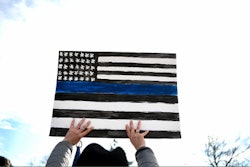The offender was reportedly armed with a handgun and threatening his wife in their home.
Officers opened fire, wounding the man.
The injured officer reportedly suffered undisclosed non-life threatening injuries, but all too many cops have been killed responding to DV calls.
Others have suffered career-ending injuries.
Here are some tips on staying safe on these types of calls for service, and ensuring the welfare of the individuals who have been victimized.
1. Intel
Officers are too frequently dispatched to a DV call with very little information about what they're walking into. Try to obtain as much information as possible about the residents and known associates at the location of the incident. This begins with a reminder to 911 call takers and dispatchers to gather as much information at the time of the 911 call. Have police been there before for previous offenses? How many times and how recently? What were the outcomes of those calls? Ideally, the call taker is still on the line as you arrive to the scene, providing near-real-time intelligence on what is likely to be a situation in flux.
2. Backup
Responding to a domestic violence call is not a solo activity. Unless there are exigent circumstances in which someone's safety is in immediate peril, wait for backup to arrive before entering the household. This is not just for contact and cover tactics—although that's a big part of it. Dealing with two parties who have recently been in an altercation can turn messy in a hurry, and there is strength in numbers.
3. Approach
Don't park your patrol vehicle directly in front of the residence. Park some distance away and approach on foot. An attack with a firearm on an officer responding to a domestic call is most likely to occur when making the approach to the residence, with the attacker lying in wait for an ambush. Be stealthy in your approach, taking time to take in what you can about the scene. And please, don't stand directly in front of the door when you knock. This seems obvious, but complacency sometimes sets in and simple mistakes are made. I've seen it happen.
4. Observation
Once inside the home, be sure to very carefully survey the scene. Read the room. Ask yourself, "Who is here at the scene? Who among the people present appears to pose a threat? Are there firearms or edged weapons visible? Where are the places where such weapons might be secreted away? What can be used as an improvised weapon? Would it be safer if we took this discussion outside?"
5. Impairment
While I was unable to find in my research for this column any empirical data on the percentage of DV calls involving persons who are either drunk or high on an illegal substance, experiential knowledge tells me it's a factor in a fairly significant proportion of such incidents. Drunken people—and those under the influence of illegal narcotics—have a tendency to do stupid and wildly unpredictable things.
6. Barriers
The most likely room for an interaction with a domestic violence suspect and their victim is the living room. The second most likely is the kitchen. Both rooms typically present natural barriers—couches, chairs, kitchen tables, and the like—that you can use to make an attack on you more difficult. On the subject of kitchens: if the initial contact is made in the kitchen, do your level best to relocate to another location. There are always edged weapons present in the kitchen, as well as other objects that can be turned into improvised weapons.
7. Separation
In an ideal world, four officers would respond to any DV call. This would allow two officers to interview the victim and two to interview the accused. This is not always possible—especially for smaller agencies with limited personnel on the streets at any one time—so at the very minimum, you want your victim and the subject as far from each other as possible, but still within view. Ideally, the accused cannot see the victim (and vice versa), but officers have eyes on both of them.
8. Assumptions
Don't immediately assume that the victim is not also a potential assailant. Domestic violence victims have launched sudden attacks on officers when they come to the realization that the arrest of their attacker will also have adverse effects on them. They may have called the police to "just make it stop" not comprehending at the time that their spouse or partner would end up handcuffed in the back of a squad car. They suddenly realize that the person being hauled away to jail may not be able to pay the rent if found guilty and incarcerated. And don't assume that the victim wasn't also guilty of domestic violence as well. Be mindful that your subject may also have sustained injuries during the incident.
9. Children
The presence of children significantly complicates the call. Not only must they be kept safe during the process of interviewing the victim, the accused, and any available witnesses, it's a very good idea to take some time after the suspect has been taken into custody to talk with the kids about what happened and what's likely to happen next. A good friend of mine calls this "taking the extra minute" and it can go a long way to helping a young person—who is also a victim of trauma when they bear witness to violence in the home—to get through the situation.
10. Follow-up
What if the abuser goes to jail but is soon released on bond? What if the offender is not taken into custody and told simply to leave the residence and stay somewhere else for a period of time? What is the probability that they will return after the police have left? Try to make a point of swinging by the dwelling if you're driving around on patrol and not in the midst of another response activity. It's also a good idea to have written down, stored in your phone, or committed to memory the telephone number and/or address of area shelters that specialize in supporting and housing victims of domestic violence.
11. Proactive
Finally, remember that domestic violence is one of the most chronically underreported crimes in America. If you're dispatched to a location for an entirely unrelated call and observe an individual present with signs of being recently abused, ask the appropriate questions and take the appropriate actions. Individuals who commit domestic violence—and are undiscovered—all too often escalate their attacks. They rarely stop of their own volition. Proactively taking these dangerous individuals away from their victims can save a person's life.
Conclusion
No two domestic violence calls are alike. Some end with the parties agreeing to get counseling and finding a way to stop the violence from happening. Some never really end, with abuse continuing for months or years. Other calls end with someone at the scene deciding to launch an attack on the responding officers.
Stay safe out there, my friends.















